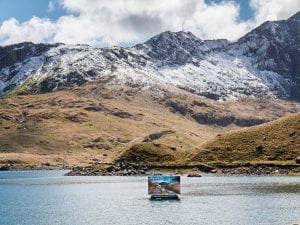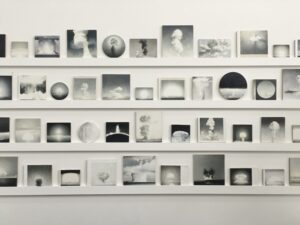Whereas traditional photographers convey extracts of reality, South Korean multidisciplinary artist JeeYoung Lee offers excerpts from her dreams, heart and memory. She reinterprets her psychological landscape into stage sets. The Stage of Mind series began with self-reflection; she asked: “where am I in my mind?” The project is a way for Lee to question her identity and contemplate existence. She creates the fabric of a universe born from her mind within the confines of her studio. Unrestrained by the limits of the conventional photography, she adds theatrical performance to breathe life into her creations. In the studio, imagined worlds become real. In this interview, Lee tells us about how her practice is rooted in personal experiences, her creative process and the inspiration behind the piece Monsoon Season.
A: Why did you decide to present your psychological landscapes in the form of stage sets and photography?
JL: What I make is a recreation of my mental landscape, so it is surreal, but it is “real” to me because it reflects my experience and emotions. I materialise what is in my head by building a physical stage and documenting the scene through photography, a medium that is used to record reality. The final result is the still image but I consider the entire process of creating a stage set, posing, shooting and destroying the set an integral part of my artistic creations. Capturing a moment in time, making an installation, and posing behind the camera allows me to take a step back and observe the experience as a third person. In other words, I relive the experience as the protagonist and an observer. Analysing the self is one of my motivations as a creator. My artwork allows me to look back at my experience and it also helps me get over the emotions involved with that experience.

A: Could you tell us about the meaning behind Monsoon Season?
JL: Monsoon Season was inspired by a flood in my old basement studio during the summer of 2010. The figure with her plastic spoon oar sits within a disposable cup above the tentacle-like sea (reminiscent of sea anemones). My intention was to evoke a sense of jeopardy and weakness by using disposable items instead of an actual boat and a paddle. Sea anemones prey on small fish by luring them with their elaborate tentacles. They have lethal cnidocytes which release poison at intruders or prey. The tentacles in this work represent a negative and difficult crisis to convey what it feels like being exposed to a violent situation. It is also a metaphor for overcoming adversities in life – like walking through a briar patch.
A: How do you approach composition when working with both 3D sets and 2D photographs?
JL: When I set on a certain subject or idea, I create a rough sketch and spend time deciding on the details. I test different materials to bring to life what I have envisioned, determining how to build the props and carefully selecting the colours I want to use. In my studio, there is an adjustable wooden stage. I fix the stage walls, paint the setting, make the objects and place them where they are needed. It depends on the project but each set takes approximately two or three months to complete. Only then can I take a photograph. I’m not only planning the elements of the stage set during the conception stage but I’m also visualising the final scene in my head. When it comes to photography, I typically have a specific angle in mind, including the model’s position and pose. However, sometimes I also take multiple photographs from various angles. In the end, only one is chosen as the final outcome. Since I appear as the model in most cases, my photographs also have the characteristics of a performance.

A: In what ways has your approach to art evolved over time?
JL: My work began with self-reflection. I have constantly questioned my identity and contemplated my existence. As I’ve navigated through different stages of my own life, my artwork has evolved to reflect a variety of personal experiences and life lessons. I use my artwork as a means of self-expression, self-discovery, and reflection. As my growth as an artist continues, I aim to diversify the mediums I explore, expanding my artistic horizons. I’m currently in the process of branching out into immersive installation, delving into video, and further exploring photography itself. This exploration has enriched my work, enabling me to convey my ideas in more ways.
A: What does being a finalist for the Aesthetica Art Prize mean to you? And, what projects are you working on at the moment?
JL: Being selected as a finalist for this art prize is truly an honour. I really appreciate this opportunity. And I’m very excited to show my work to UK audiences. Currently, I am working on new works for the Stage of Mind series. And I am happy to inform you that I have two upcoming solo exhibitions in Seoul soon. The first show will be held at the Government Complex Seoul’s gallery from 29 March to 26 April, and the second exhibition is scheduled at OCI Museum of Art from 4 July to 10 August. I will be unveiling my new series Into The Mist in the second solo show.
Lee will feature in the Aesthetica Art Prize 2024 Exhibition at York Art Gallery from 16 February – 21 April. Meet over 250 longlisted international artists in our new online gallery.
Want to get involved? The next edition of the Prize is open for entries. Submit your work by 31 August. Win £10,000, exhibition and publication. Find out more here.
Image Credits:
- JeeYoung Lee, Loveseek, (2014). From the series Stage of Mind (2007 – ongoing). Pigment print.
- JeeYoung Lee, Monsoon Season, (2011). From the series Stage of Mind (2007 – ongoing). Pigment print.





